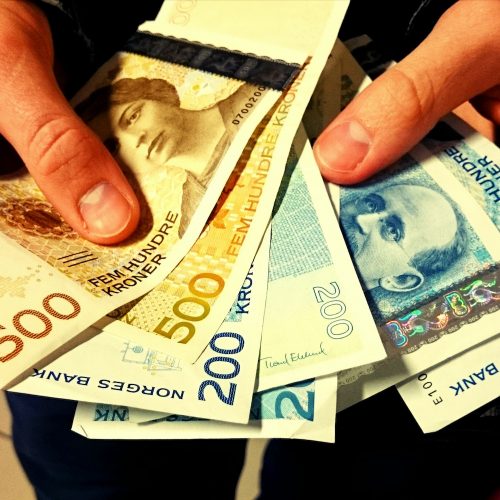THE ISSUE OF the currency of an independent Scotland has bedevilled the SNP, and so it should. The SNP seems to have accepted that Scotland cannot use the pound in the medium term; Alba has realised that Scotland cannot use it at all.
Both parties are having to react to the acknowledgement that EU membership would mean joining the euro by first establishing a Scottish currency, undergoing the pain to meet the criteria for putting it into the Exchange Rate Mechanism (ERM), accepting the pain within the ERM to meet the euro compliance criteria, and then suffering the unending pain of euro membership.
Now it is a question of casting around for some other version that looks workable superficially, but which hangs off another established currency, like using the Norwegian krone (the NOK). This version was floated in 2014 by Piotr Jaworski, a pro-independence professor of Economics at Edinburgh Napier University, and it has now been renewed.
The proposal is an oxymoron: that Scotland should become independent and then use a currency without having any voice in the monetary policies behind that currency – worse even than having a tiny minority voice in the euro.
As in 2014, the SNP wants to project a rosy parallel of an independent Scotland to Norway’s high prosperity built on oil and gas. However, oil and gas delivers only £700 million out of Scotland’s £66bn of tax revenues – 10.6 per cent – whilst public expenditure is £81bn, leaving a deficit of £15bn, which is 23 per cent of tax revenues and 8.6 per cent of GDP.
Population size is about all that Scotland and Norway have had in common, except for the period when the oil and gas was flowing. Norway never had extensive heavy industry: coal, iron and steel, vehicles, railways, chemicals, armaments. Post-industrial issues have been cushioned by oil and gas jobs and money.
Now the countries have diverged again.[1] Norway has a GDP of £261bn, a GDP per head of £49,231, an annual budget surplus of 4.4 per cent of GDP, a national debt of £122.4bn or 36 per cent of GDP, and a AAA public credit rating. These statistics make Norway a very rich country.
Scotland has a GDP of £169bn, a GDP per head of £30,727, an annual budget deficit of -8.6 per cent of GDP, and a national debt of £154bn or 88 per cent of GDP.[2] It has no public credit rating of its own: it raises debt through the UK’s public credit rating of AA. These statistics might not even secure Scotland an Investment Grade credit rating of BBB-: that is Italy’s rating and its budget deficit was in the region of 2.5 per cent pre-pandemic, not 9 per cent.
Scotland and Norway have significant exports and herein lies the major risk for Scotland of adopting the NOK, an ultra-hard currency.
Norway’s 2019 exports were 54.5 per cent of GDP.[3] Around 39 per cent of exports (equating to £55.5bn and 21 per cent of GDP) went to countries with an equally hard currency as the NOK (EUR or SEK); 60 per cent went to countries with a potentially weaker currency, including 18 per cent to their biggest single export market – the UK.
Scotland’s exports equate to 50 per cent of its GDP.[4] But 81 per cent of Scotland’s exports – and 41 per cent of its GDP – go to countries with a potentially weaker currency than the NOK, with the rest of the UK way out in the lead.
81 per cent of Scotland’s exports, if priced in NOK, would be at risk of costing the buyer more, leading buyers to reduce purchases or to finding an alternative source of supply. This represents an enormous risk on currency mismatch when Scotland could only pay for its national debt and its other costs if these exports both continued and yielded the same amount of tax revenues.
Norway’s risk of loss is far lower than Scotland’s as a percentage of GDP, and it has an enormous loss-absorption buffer in the shape of its sovereign wealth fund of £970bn (amassed from its oil and gas tax revenues).[5] In 2014 the SNP claimed Scotland should be endowed with a similar fund for all the oil and gas tax revenues supposedly spent by England on itself. In “The Smith Commission – buying the great SNP bluff”, published in 2015, it was proven that the oil and gas tax revenue had simply been recycled through Westminster and back to Edinburgh, and had all been spent in Scotland in the form of the Barnett Formula premium.[6]
With this huge cushion and its position as a major net creditor of the global financial system, Norway’s situation is incomparable with that of Scotland: a net debtor and, if Prof Jaworksi’s plan were adopted, with its debts and obligations in an ultra-hard currency and 41 per cent of its revenues in soft ones. This is a recipe for a disaster on the Zimbabwean model.
In fact there is no right answer for the currency of an independent Scotland in 2021, just like there was no right answer in 2014. Hanging off Norway is just the latest, superficially attractive fairytale, or eventyr, in Norwegian.
If you appreciated this article please share and follow us on Twitter here – and like and comment on facebook here.
Photo of Norwegian Krone by moura_vanessa from Adobe Stock
[1] Statistics are not always from exactly coterminous time periods, and have been selected to have a minimum overlap with the pandemic where this is possible
[2] GERS figures use the measure of “Population share” for many statistics; Scotland’s “Population share” of the UK is 8.2 per cent, and by that token Scotland would have taken over £149.2bn of the UK’s national debt of £1.82trn in 2019
[3] Norway’s exports: £142.3bn – 18 per cent to the UK, 14 per cent to Germany, 10 per cent to the Netherlands, 9 per cent to Sweden, 6 per cent to France and 5 per cent to the USA
[4] 60 per cent of Scotland’s exports (£51.2bn) are to the rest of the UK, 19 per cent (£16.1bn) to the EU and 21 per cent (£17.7bn) to the Rest of the World. Source: Scottish export statistics 2018 – https://www.gov.scot/publications/export-stats-scotland-2018/ accessed on 22 April 2021
[5] Balance of Norway’s sovereign wealth fund: https://www.nbim.no/en/ accessed on 22 April 2021
[6] http://www.lyddonconsulting.com/the-smith-commission-buying-the-great-snp-bluff-february-2015/









